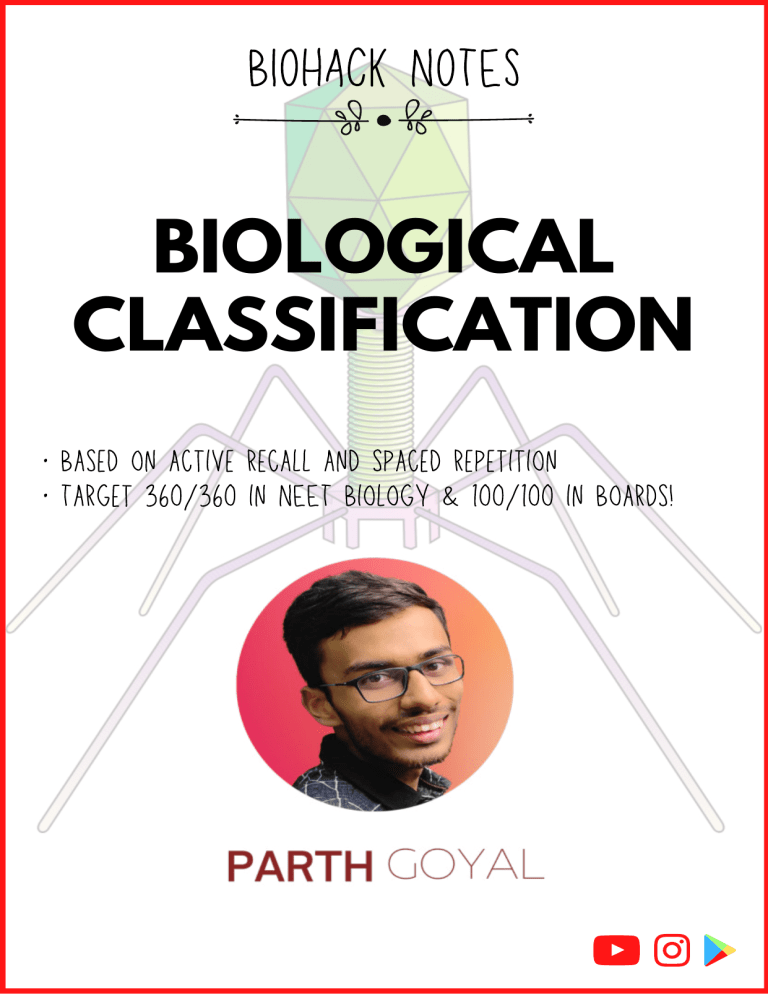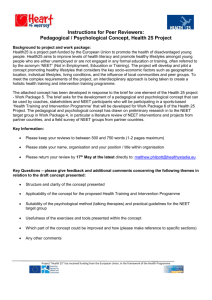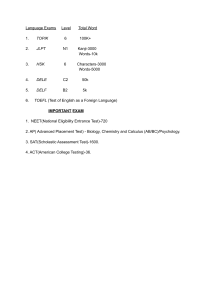
BIOHACK NOTES BIOLOGICAL CLASSIFICATION • Based on active recall and spaced repetition • Target 360/360 in NEET Biology & 100/100 in Boards! • INTRODUCTION 1) ______ was the earliest to attempt a scientific basis of classification. 2) Aristotle classified plants into _____,_____ and______ 3) He divided animals into ____ no of groups, one with ______ and one those did not. 4) Monera cell wall is made up of _______ and ________ 5) All protists don't contain a cell wall. T/F 6) Loose tissue body of organisation is present in _______ 7) Monerans cannot be saprophytic. T/F 8) Holozoic mode of nutrition is present in _______ kingdom, 9) The Animalia kingdom contains saprophytic animals. T/F 10) Whittaker gave 5 kingdom classification in ______ year. 11) Criterias used by Whittaker for classification was (5) (NEET) 12) Earlier Chlamydomonas and Spirogyra were placed together under _______ 13) Kingdom ______ has brought together ________ and ________ (having cell wall) with ______ and ______ (lacking cell wall). (NEET) 14) Phylogenetic means ? (NEET) • KINGDOM MONERA 15) _______ are the sole members of kingdom monera. 16) 4 categories based on shape 17) Bacterial structure is very complex, yet they are very simple in behavior. T/F 18) The ________ shows the most extensive metabolic diversity. (NEET) 19) Vast majority of bacteria are autotrophs. T/F DigaQ. 1 Y X D C A B • ARCHAEBACTERIA 20) _________ bacteria live in some of the most harsh habitats 21) Name the 3 divisions of archaebacteria and their habitat. (NEET) 22) Archaebacteria differs from others by having _________. (NEET) 23) The reason for the survival of archaebacteria in extreme conditions is ? 24) _______ are present in the gut of ruminants. (NEET) 25) Methanogens are chemoautotrophs/chemoheterotrophs. • EUBACTERIA 26) Eubacteria have rigid cell wall. T/F DigaQ. 2 27) Eubacteria, if motile, contains cilia. T/F 28) Cyanobacteria is also called ________ have ______ A type of chlorophyll. 29) Cyanobacteria can't be filamentous. T/F (NEET) 30) Cyanobacteria can be colonial. T/F 31) The colonies of cyanobacteria are surrounded by ________ 32) They form ______ in polluted water. 33) Some can fix atmospheric nitrogen in specialised cells called _________ 34) Ex of bacteria containing heterocyst are (2) (NEET) 35) ____________ bacteria oxidise various inorganic substances such as _____, _____, ______ for energy. (NEET) 36) ___________ play a great role in recycling of nutrients like (4) 37) ____________ bacteria are most abundant in nature. (NEET) 38) Nostoc is a filamentous/unicellular cyanobacteria. (NEET) 39) _________ are helpful in making curd from milk, production of antibiotics. (NEET) 40) Heterotrophic bacteria help in fixation of nitrogen in roots. T/F 41) Name the 4 well known diseases caused by bacteria and their causative agent. (NEET) 42) Bacteria produce spores in favorable conditions. T/F 43) In bacteria, a primitive type of sexual reproduction is also present. T/F 44) 3 ways through which bacteria reproduce 45) 3 ways through which bacteria do sexual reproduction - B 46) _________ completely lack cell wall. (NEET) 47) Mycoplasma cannot survive without oxygen. T/F (NEET) 48) __________ are the smallest living organism. (NEET) A DigaQ. 3 B C 49) Mycoplasma are never pathogenic. T/F (NEET) • KINGDOM PROTISTA 50) All ________ are placed under Protista. (NEET) 51) Groups under protista are (5) 52) Members of protists are primarily _______ 53) This kingdom forms a link with other kingdoms. T/F • CHRYSOPHYTES 54) This group include ______ and _______ (NEET) 55) They are found only in marine water . T/F 56) They are microscopic and are planktons. T/F (NEET) 57) What are planktons ? 58) Most of them are _________ 59) The cell wall form two thick/thin overlapping shells, which fit together as in a _______ (NEET) 60) The walls are embedded with _____ and thus the walls are destructible/indestructible. (NEET) 61) What is diatomaceous earth ? (NEET) 62) Diatomaceous earth is used in (3). 63) _______ are chief producers of oceans. (NEET) • DINOFLAGELLATES 64) They are mostly marine/free water and ________ 65) They appear of 5 colour - (Rang birange :)) 66) The cell wall has ___________ in the outer surface. 67) They have 2 cilla. T/F 68) Both the flagella are perpendicular to each other. T/F 69) Red dinoflagellates ex (1) 70) Red tides occur due to 71) Red tides are good for marine fishes. T/F DigaQ. 4 - A • EUGLENOIDS DigaQ. 4 - B 72) Majority of them are marine/fresh water. 73) Are found in stagnant water T/F. 74) Instead of cell wall, they have ______ which is rich in _______ 75) Euglenoids have a flexible body. T/F 76) Euglenoids have one single long flagella. T/F 77) Pigments of euglenoids are identical to those present in ________ 78) They are permanent autotrophs. T/F 79) Ex - (1) • SLIME MOULDS 80) Slime moulds are __________ protist. 81) Under suitable/unsuitable conditions, they form a DigaQ. 4 - C aggregation called _________ 82) Plasmodium may spread over several feet. T/F 83) During favorable conditions, the plasmodium differentiates and forms fruiting bodies bearing spores at their tips. T/F 84) The spore possess true/false walls. 85) The spores are dispersed by _______ • PROTOZOANS 86) All protozoans are _________ 87) Protozoans live as _______ or _______ 88) _______ are believed to be primitive relatives of animals. 89) 4 major groups of protozoans are - DigaQ. 4 - D 90) Habitat of ameboid protozoans. (3) 91) They capture their prey by ________ (NEET) 92) They have _____ shells on their surface. 93) Ex of ameboid parasite (1) 94) Habitat of flagellated protozoans (2) 95) Flagellated protozoans ex (1) and the disease it cause 96) Ciliated protozoans have cavity called ______ 97) Ex - (1) 98) Sporozoans have a ______ spore like stage. 99) Sporozoans ex (1) and the disease it cause – • KINGDOM FUNGI 100) Fungi are cosmopolitan. T/F 101) The fungi kingdom only contains multicellular organisms. T/F 102) Their bodies contains long, ______ like structures called ______ 103) The network of hyphae is called _______ 104) What are coenocytic hyphae ? 105) The cell wall is composed of ______ and ________ (NEET) 106) Fungi are also parasitic. T/F 107) Symbionts ex (2) 108) Rep by vegetative means by (3) 109) Rep by asexual means by spores called _______or _______or_______ 110) Sexual rep by (3) 111) The spores are produced in _______ 112) Sexual cycle involves 3 steps 113) Dikaryophase is present in (2) 114) In dikaryon cell, 2n condition is present. T/F 115) Basis of division of the kingdom is (3) • PHYCOMYCETES 116) Phycomycetes can't be obligate parasites on plants. T/F 117) Mycelium is aseptate/septate and ______ 118) Asexual rep by (2) 119) These spores are end/exogenously produced in ________ 120) A ______ is formed by fusion of two gametes. 121) Gametes are of 3 types 122) Ex (3) 123) _______ is a parasitic fungi on mustard. DigaQ. 5 - A • ASCOMYCETES 124) Commonly known as ______ DigaQ. 5 - B 125) Yeast scientific name is ___________ (NEET) 126) Modes of nutrition seen are - (4) 127) Mycelium branched/unbranched and septate/aseptate. 128) Asexual spore are 129) Conidia are produced on endo/exogenously. 130) Conidia on germination produce ________ 131) Sexual spore name ______ and produced endo/exogenously. 132) Sexual spore produced in _____ which are ____ like. 133) These asci are arranged in different types of fruiting bodies called _______ 134) Ex (3) 135) ________ is used extensively in biochemical and genetic work. (NEET) 136) ______ and _______ are edible. (NEET) • BASIDIOMYCETES 137) Commonly known forms are _______, ______ or _______ (NEET) 138) Ex of parasitic basidiomycetes. (2) 139) Mycelium branched/unbranched and septate/aseptate. 140) Asexual spores are generally found. T/F 141) Vegetative rep by ________ is common. 142) Sex organs are present. T/F 143) Sexual reproduction is present . T/F 144) Plasmogamy occur through ______ 145) The resultant structure is ________ which ultimately give rise to _______ 146) Karyogamy and meiosis occur in _______ 147) Basidiospores are endogenously/exogenously produced on ______ 148) Basidia are arranged in fruiting bodies called ________ 149) Ex (3) (NEET) DigaQ. 5 - C • DEUTEROMYCETES 150) Commonly known as ________ (NEET) 151) They are imperfect fungi because - (NEET) 152) Reproduce by spore called _______ 153) Mycelium features (2) (NEET) 154) Mode of nutrition is (3) (NEET) 155) They help in mineral cycling. T/F (NEET) 156) Ex (3) • KINGDOM PLANTAE AND ANIMALIA 157) Ex of insectivorous plant (2). 158) Ex of a parasitic plant. (1) 159) Animals stores food as _____ or _____ 160) All plants are eukaryotic chlorophyll containing organisms. T/F • VIRUSES, VIROIDS, PRIONS AND LICHENS 161) In the Whittaker classification, he didn't include ________ organisms. 162) Virus have ____________ structure outside the living cell. 163) "Virus" means _______ or ________ 164) ___________ gave virus its name. 165) _________ recognised in year ____ certain microbes as causal agents of mosaic disease of tobacco. (NEET) 166) ___________ saw that extract from infected plants cause infection in healthy plants hence called the fluid _______ in year ______ (NEET) 167) ____ (year) showed that viruses could be crystalilsed. (NEET) 168) Virus crystal consist largely of ________ 169) Virus are not obligate parasite, they can be helpful too. T/F 170) Virus can contain both RNA and DNA. T/F 171) A virus is in short a ____________ 172) Virus infecting plant have ______ genetic material. 173) Virus infecting animals have ______ genetic material. A B DigaQ. 6 - X 174) Bacteriophages means ? 175) Genetic material of bacteriophages is C 176) The protein coat is made up of _______ (NEET) 177) These capsomeres are arranged in _____ or _____ geometric forms. D E 178) Viral diseases in humans ex. (5) 179) In plants, viral diseases are (5) 180) Viroids were discovered by ______ in _____ year. 181) Viroids are bigger than virus. T/F (NEET) 182) It is a free RNA/DNA. (NEET) F DigaQ. 6 - Y 183) It lacks a protein coat. T/F 184) The RNA of viroid was of high molecular weight. T/F (NEET) 185) _______ are mis-folded proteins. 186) Prions cause __________ in cattle and its analogous variant _________ in humans. 187) Algal component of lichen is called _______ and fungal is called _______ 188) Fxn of algal and fungal component respectively are 189) Lichen are very good indicators of ________. They don't grow in ______ (NEET) BIOLOGICAL CLASSIFICATION ANSWERS • ANSWERS 8. Animal 9. T 10. 1969 1. Aristotle 11. cell structure, body organisation, mode of 2. Trees, shrubs and herbs nutrition, reproduction and phylogenetic 3. Had red blood and those that did not relationships 4. Polysaccharide + amino acid 12. Algae 5. T 13. Protista, Chlamydomonas and Chlorella, 6. Fungi Paramoecium and Amoeba 7. F 14. Based on evolutionary relationship • MONERA 23. Same as 22 and also absence of peptidoglycan 15. Bacteria 24. Methanogens 16. Cocci, bacillus, vibrium, spirillum 25. Chemoautotrophs 17. F Eubacteria 18. Bacteria as a group 19. F 26. T 27. F Archaebacteria 20. Archaebacteria 21. extreme salty areas (halophiles), hot springs (thermoacidophiles) and marshy areas (methanogens) 22. Different cell wall structure, branched chain lipids (phytanyl side chains) 28. Blue green algae, chl a 29. F 30. T 31. Gelatinous sheath 62. Polishing, filtration of oils and syrups 32. Blooms 63. Diatoms 33. Heterocysts 64. Marine, photosynthetic 34. Anabaena, Nostoc 65. Yellow, green, brown, blue, red 35. Chemosynthetic autotrophs, nitrates, nitrites 66. Stiff cellulosic plates and ammonia 67. F 36. Chemosynthetic autotrophs, N,P,Fe,S 68. T 37. Heterotrophic 69. Gonyaulax 38. Filamentous 70. Rapid multiplication of red dinoflagellates 39. Heterotrophic bacteria 71. F, they kill them 40. T 72. Fresh 41. Cholera (Vibrio cholerae), typhoid (Salmonella 73. T typhi), tetanus (Clostridium tetani), citrus canker 74. Pellicle, protein (Xanthomonas citri) 75. T 42. F 76. F, two flagella, one short one long 43. T 77. Higher plants 44. Fission, spore formation, sexual reproduction 78. F 45. Transformation, Conjugation, Transduction 79. Euglena 46. Mycoplasma 80. Saprophytic 47. F 81. Suitable, plasmodium 48. Mycoplasma 82. T 49. F 83. F, unfavorable • 84. True KINGDOM PROTISTA 50. Single celled eukaryotes 85. Air currents 51. Chrysophytes, Dinoflagellates, Euglenoids, Slime 86. Heterotrophs moulds and Protozoans 87. Predators or parasites 52. Aquatic 88. Protozonas 53. T 89. Amoeboid, Flagellated, Cilliated and Sporozoans 54. Diatoms and Golden algae(desmids) 90. Fresh water, sea water or moist soil 55. F, fresh water also 91. Putting out pseudopodia 56. T 92. Silica 57. Those who float passively in water currents 93. Ameoba 58. Photosynthetic 94. Free-living or parasitic 59. Diatoms 60. Silica, indestructible 61. Cell wall deposits of diatoms 95. Trypanosoma - Sleeping sickness 126. Saprophytic, decomposers, parasitic or 96. Gullet coprophilous 97. Paramoecium 127. branched , septate 98. Infective 128. Conidia 99. Plasmodium • – Malaria KINGDOM FUNGI 129. Exogenously 130. Mycelium 100. T 131. Ascospore, endo 101. F 132. Asci, sac like 102. Slender thread, hyphae 133. Ascocarps 103. Mycelium 134. Aspergillus, Claviceps and Neurospora 104. Hyphae are continuous tubes filled with 135. Neurospora multinucleated cytoplasm 136. Morels and truffles 105. Chitin and polysaccharide 137. Mushrooms, bracket fungi and puffballs 106. T 138. Rusts and smuts 107. Lichen, mycorrhiza 139. Branches and septate 108. Fragmentation, fission and budding 140. F 109. Conidia or sporangiospore or zoospore 141. Fragmentation 110. Oospore, ascospore and basidiospore 142. F 111. Fruiting bodies 143. T 112. Plasmogamy, Karyogamy and meiosis 144. Somatic fusion 113. Ascomycetes and Basidiomycetes 145. Dikaryotic, basidium 114. F 146. Basidium 115. Morphology of mycelium, mode of spore 147. Exo, basidium formation and fruiting bodies 148. Basidiocarps 116. F 149. Agaricus (mushroom), Ustilago (smut) and 117. Aseptate, coenocytic Puccinia (rust fungus) 118. Zoospore (motile) or aploanospore(non-motile) 150. Imperfect fungi 119. Endo. sporangium 151. Sexual phase not present 120. Zygospore 152. Conidia 121. Isogamous, anisogamous and oogamous 153. Septate, branched 122. Mucor, Albugo, Rhizopus 154. Saprophhytes, parasitic, decomposers of litter 123. Albugo 155. T 124. Sac-fungi 156. Alternaria, Colletotrichum and Trichoderma 125. Saccharomyces • KINGDOM PLANTAE & ANIMALIA 179. mosaic formation, leaf rolling and curling, 157. Bladderwort, Venus fly trap yellowing and vein clearing, dwarfing and stunted 158. Cuscuta growth. 159. Glycogen and fat 180. T.O. Diener, 1971 160. F 181. F • 182. RNA VIRUSES, VIROIDS AND LICHENS 161. Acellular 183. T 162. Inert crystalline 184. F 163. Venom, poisonous fluid 185. Prions 164. Pasteur 186. bovine spongiform encephalopathy (BSE) 165. D.J. Ivanowsky (1892) commonly called mad cow disease, Cr Jacob disease 166. M.W. Beijerinek, contagium vivum fluidum, 1898 (CJD) 167. W.M. Stanley (1935) 187. Phycobiont, mycobiont 168. Proteins 188. . Algae prepare food for fungi and fungi provide 169. F shelter and absorb mineral nutrients and water 170. F 189. Pollution, polluted areas – 171. Nucleoprotein DigaQs 172. ssRNA • 173. ssRNA or dsRNA or dsDNA DigaQ. 1 174. Virus that infect bacteria A 175. dsDNA 176. Capsomeres 177. Helical or polyhedral 178. mumps, small pox, herpes and influenza. AIDS – Cocci B – Bacilli C – Spirilla D – Vibrio – Spore Y – Flagellum X DigaQ. 2 - Nostoc – Heterocyst B – Mucilaginous sheath A DigaQ. 3 - A dividing bacterium – Cell wall B – Cell membrane C – DNA A DigaQ. 4 – Dinoflagellates B – Euglena C – Slime mould D – Paramoecium A DigaQ. 5 – Mucor B – Aspergillus A DigaQ. 6 – Tobacco Mosaic Virus (TMV) Y – Bacteriophage A – RNA B – Capsid C – Head D – Collar E – Sheath F – Tail fibres X FRIEND: TERE BIO MAI 360/360 KAISE AA GAYE ??!! LE YOU* SCAN AND DONATE US SO THAT WE CAN CREATE MORE SUCH QUALITY CONTENT FOR YOU! JUST ₹10-20 WILL BE APPRECIABLE! :)





